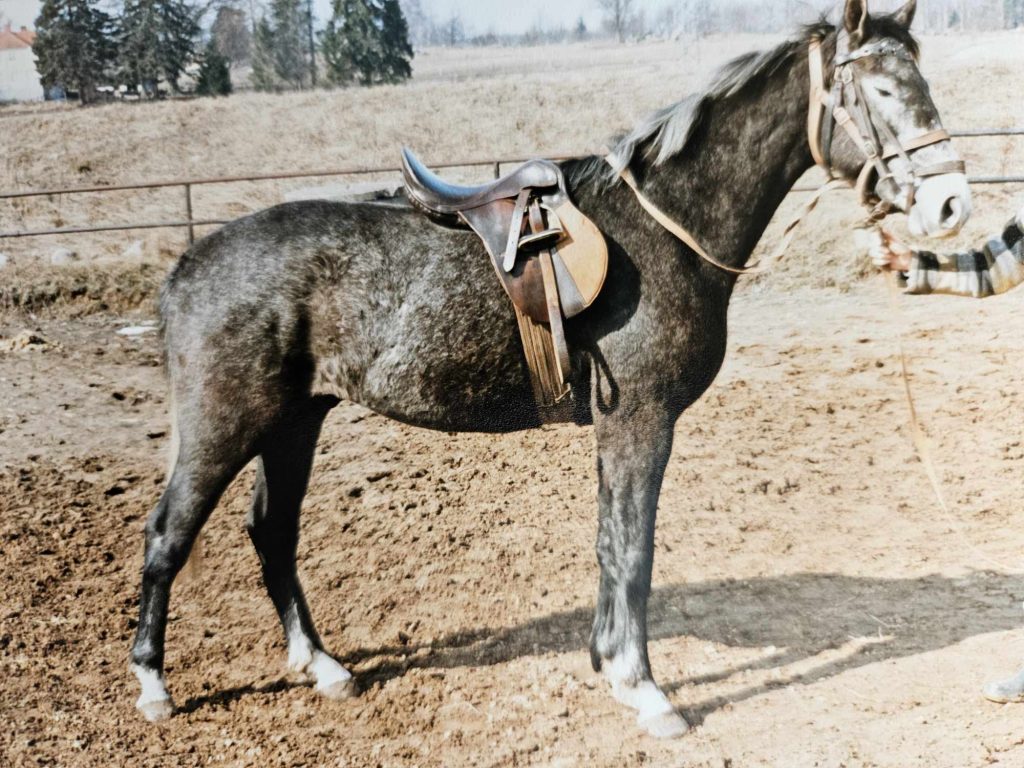My Most Difficult and Worst Horse!
About 40 years ago, I lived in Mörrum. I really enjoyed it there and had many wonderful friends. Among them were Ann and Lasse, a couple from whom I had bought a Collie. They were also interested in horses.
Ann had decided she wanted to buy a hobby horse—one she could ride a little and perhaps breed a foal from. She had found an ad from Erik Nilsén, a well-known eventing rider and breeder, who was reducing his breeding program. He had many horses, so there were plenty of options to look at. Ann asked if I wanted to come along, and of course, I said yes—I never turn down an opportunity to meet like-minded horse enthusiasts and see beautiful horses.
I was also looking for a new horse myself. I was tired of constantly buying young horses, training them, and then selling them. It meant that I never really progressed in my own riding or in competitions. Now, I wanted an older horse, one that was already trained so I could continue working with it.
Visiting Nilsén
We set off to see what Nilsén had to offer, and there was truly a large selection! A herd of 35–40 horses roamed the pasture. It was early spring, so they were all shaggy and rough-coated, but you could still see the quality of the horses beneath the thick fur.
Ann explained what she was looking for, and Nilsén recommended a chestnut mare called The Merry Widow. She had been unrideable until the age of seven, but they had finally managed to train her. Now, she was the sweetest horse and had even been used in a riding school. She seemed calm and reliable, and Ann fell for her immediately. There was no doubt—she was getting The Widow.
After looking at all the horses, Ann asked:
“Haven’t you found one?”
I had decided to buy a trained horse, but one still caught my eye—a gray horse with incredible movement. I tried to be sensible but couldn’t help asking about the price. It turned out he was a four-year-old gelding—and The Widow’s son! Ann thought it was an obvious choice for me to buy him—it would be so much fun.
The price was also very low, so the decision was made quickly. I figured that if he didn’t turn out as I wanted, I could always sell him later.
Markant Moves In
The horses at Nilsén’s farm were used to being outdoors a lot and were kept in tie stalls overnight, so he was accustomed to being tied up. I thought that was a big advantage. However, the young horses were not handled much, so I had to start from scratch.
I named him Markant, after a previous horse I had loved. Maybe giving him a name I liked would help? I took things very slowly with him, and at first, everything went better than expected. He accepted both the saddle and bridle, and after a while, I was able to get on. He was a very alert horse, so I took my time.
But one day, when I was going to ride him in the arena, came the first real protest. I put my foot in the stirrup, got just into the saddle—and suddenly, he exploded into a series of bucks. I had no chance of staying on.
I hit the ground hard, but I knew I had to get back on. I scrambled up, and this time, he walked quietly.
For the next few days, he was calm, but soon another outburst came. Back then, I was very brave and didn’t give up easily, but after he had thrown me off completely unprovoked several times, I started to realize it wasn’t worth risking my life for such an unpredictable horse.
Help from a Friend
I talked to Ann and Lasse about the situation. We had in the back of our minds that The Widow had been unrideable until the age of seven, so maybe Markant had inherited too much of her temperament.
Lasse, who had grown up in a competitive riding family, offered to try and see if he could work it out. I was hesitant—should I really risk my friends’ safety? But Lasse insisted, so we gave it a shot.
Mörrum’s riding arena wasn’t far from my home, so I led Markant there and had him on a lunge line. I offered to hold onto him while Lasse rode, but he preferred to ride freely so he could direct the horse where he wanted.
It didn’t take long before Markant started his acrobatics—but Lasse stayed on. We were very impressed, and I felt a flicker of hope when Markant slowed down, convinced that it had gone well.
At that very moment, Markant suddenly spun around and crashed straight through a solid wooden fence. Lasse went flying—he had absolutely not expected the horse to take off through the fence.
The horse ran home, and we walked after him. Lasse offered to try again, but I said no. I didn’t want to risk an accident, either with myself or my friends.
I realized that I truly needed an older, trained horse.
Since this is a long story, it will continue next week!
(A slightly blurry picture of Markant—people didn’t take as many pictures back then!)


